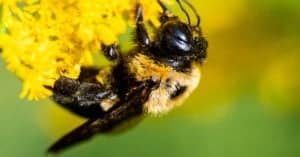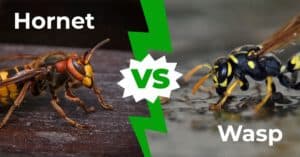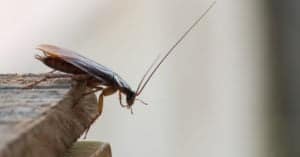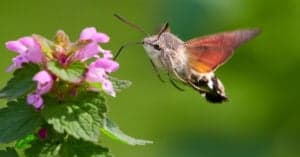Beehive Vs Wasp Nest
@media (min-width: 481px) {
.mobile-top-content {
display: none;
}
}
#mobileTopContentCTACarouselControls { overflow: hidden; text-overflow: ellipsis; white-space: nowrap; }
.mobile-top-content .more { color: #fff; }
.mobile-top-content a { color: #fff; text-decoration: underline; }
.mobile-top-content a:hover { color: #fff; text-decoration: underline; }
@media (max-width: 480px) {
.mobile-top-content {
background-color: #06a10b;
color: #fff;
text-align: center;
/*height: 60px;
padding-top:5px;*/
font-size:80%;
/* display: block; */
margin: 0px -30px;
}
}
Bees and wasps may seem similar on the outside, but in fact, they are very different insects with very different lifestyles. One of the major differences between bees and wasps is their nests. While each species of bee and wasp have their own nests, there are some general things that allow us to distinctively classify and distinguish them. We are going to be exploring the differences between beehive vs wasp nest. Let’s get started!
Comparing a beehive and a wasp nest
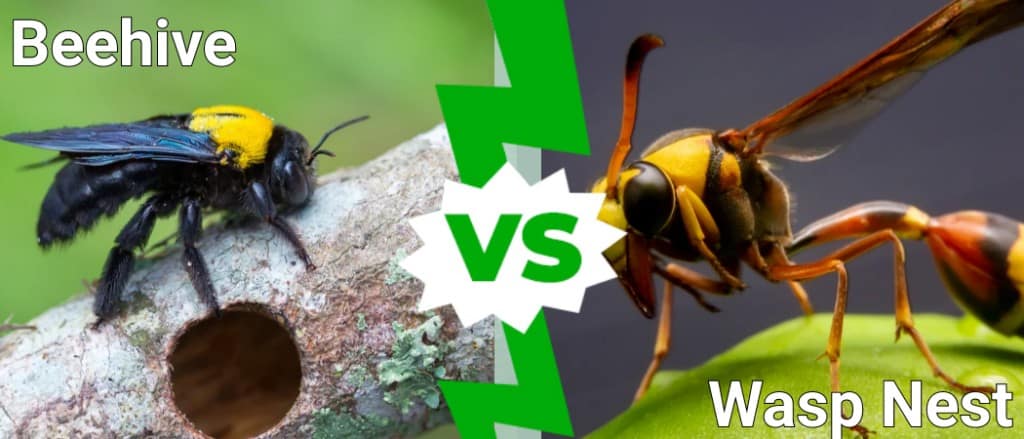
A-Z-Animals.com
| Beehive | Wasp Nest | |
| Size and Shape | 8-16 gallons of capacity in the wild, vertically elongated cylinders | Depends on species, but generally umbrella-shaped, 2-6 inches across |
| Material | Honeycomb and propolis | Wood pulp, saliva, mud |
| Colony Size | 20,000-80,000 individuals per colony | 20-40 individuals |
| Honey Production | Generally yes, but depends on the species | None |
| Location | Gardens, woodlands, and meadows where flowering plants are present | Overhangs and protected areas |
Key Differences Between a Beehive and a Wasp Nest
Beehives and wasp nests have quite a few differences between them. The primary differences between a beehive and a wasp’s nest are their size and shape, colony size, and the production or storage of honey. Let’s quickly explore those primary differences.
The main difference between beehives and wasp’s nest is their size and shape. Beehives are larger and generally more sprawling than a wasp’s nest. Wasp nests are small and umbrella-shaped. Additionally, the number of individuals within the nests is vastly different. Beehives generally house between 20,000-80,000 individuals, while wasp nests have 20-40, on average. Finally, one of the other primary differences is the use of the nest to store honey. Bees design their nests around honey storage, while wasps don’t produce any honey.
While these three primary differences are likely the most notable, there are still more to consider. Let’s explore the primary differences, as well as the secondary ones, in a more in-depth format below.
Bee Hive Vs Wasp Nest: Size and shape

Sarah2/Shutterstock.com
Bees are well known for their nests, but what do they actually look like in the wild? Often, cartoon depictions of them aren’t all that accurate. Actual beehives are generally parallel columns or sheathes of beeswax material that line up with one another, although the location mostly determines their exact shape. In some places where there is a cavity present, bees will simply fill the cavity, and their standard “look” won’t be present. When it comes to size, beehives can be massive. On average, however, wild beehives have an internal capacity of 8-16 gallons, although they can grow much larger than that. An important note to remember is that all species of bee will have different hive shapes and sizes. Most of the information today is pertaining to honeybees.
Wasps are a lot more variable when it comes to their nests, mostly because there are 75,000 plus species of them. Still, the nests that most people are familiar with are the nests of paper wasps. Paper wasps have nests that look like hanging umbrellas, usually under a covering of some sort. The underside of the umbrella has hexagonal entrances and is generally 2-4 inches across. Some wasps, hornets, for example, have much larger nests that can be the size of a basketball or larger.
Bee Hive Vs Wasp Nest: Material
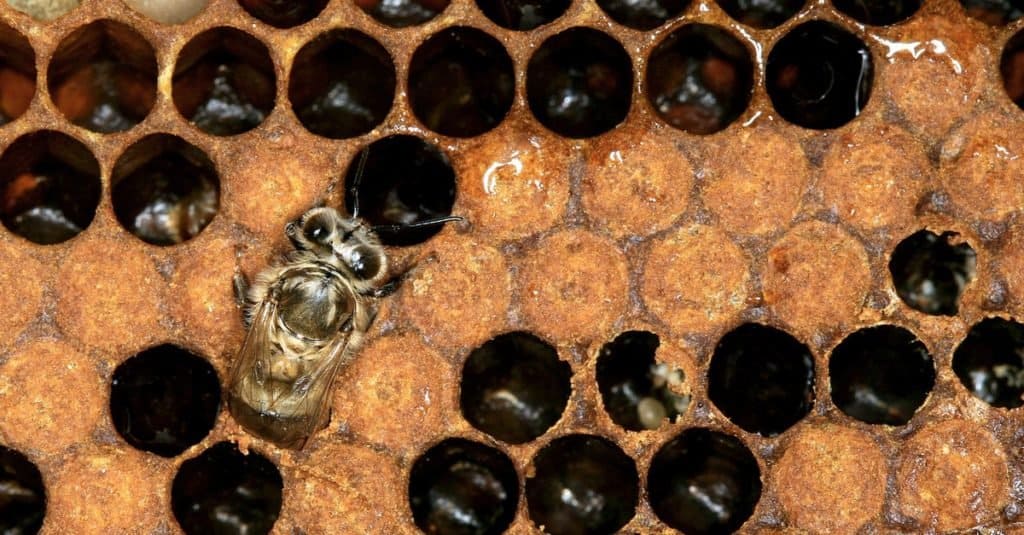
GIRODJL/Shutterstock.com
Beehives use a very famous material in the construction of their nests – beeswax! Beeswax is produced by the bees and is the result of eight glands situated on their abdomen. They take their own honey, convert the sugars within their bodies, and turn it into wax. To produce a pound of wax takes at least seven pounds of honey to be eaten by bees! Bees use a hexagonal shape in their nest construction to conserve honey and resources. This shape is mathematically amazing and allows bees to share walls for each cell, minimizing waste and maximizing storage space and structural integrity.
Wasps generally make their nests from either of these two methods: wood pulp or mud. Paper wasps, hornets, and most other colony wasps use the wood pulp method for construction. Using their mandibles, they take bits of wood and chew it to a pulp. After mixing it with their saliva, they then use it as a construction material to build their papery nests. Some wasps use mud as their primary building material. Mud daubers (dirt daubers, mud wasps) gather mud with their mandibles and form it into tubes that they live and nest in.
Bee Hive Vs Wasp Nest: Colony size

Brian Fish – Public Domain
When it comes to colony size, bees have a massive advantage. Bees generally have hives with 20,000-80,000 individuals. The queen constantly lays eggs, and the workers maintain the hive and the essential functions. Since the workers don’t die during winter (like most wasps do), they can have tens of thousands of individuals supported at a time.
Wasps are generally separated into two categories: solitary wasps and colony wasps. Solitary wasps live alone and only gather with their own species to mate. Mud daubers, tarantula hawks, and many other hunting wasps live alone. Colony wasps like paper wasps, hornets, and yellowjackets, however, can number from the tens all the way into the thousands. Most paper wasp colonies are between 20-40 individuals, but some yellowjacket colonies have been known to reach 5,000 individuals. Regardless, bees will almost always have more.
Bee Hive Vs Wasp Nest: Honey production

Aleksandr Rybalko/Shutterstock.com
Bees get a lot of their fame from their production of honey. Beehives are designed with honey in mind. The hexagonal structure within the nest is made to store honey in a wax cap and to place larval bees. Additionally, beehives rely on honey during the winter months as a food source that keeps the workers fed when there are no flowers or pollen. When the bees eat the honey in the winter, they are able to produce enough body heat to keep the hive alive during the cold months.
Wasps don’t produce honey, one of the reasons their nests don’t have to be as large. Wasps, especially colonies, eat pollen and nectar from flowers and fruits in the area. When winter comes, most of the wasps die due to a lack of food while the fertile queen will overwinter in a hidden location (often a log or some other hidden place).
More from A-Z Animals
.more-snake-card-image { max-height:140px !important; }
@media (min-width: 481px) {
.mobile-top-content {
display: none;
}
}
#mobileTopContentCTACarouselControls { overflow: hidden; text-overflow: ellipsis; white-space: nowrap; }
.mobile-top-content .more { color: #fff; }
.mobile-top-content a { color: #fff; text-decoration: underline; }
.mobile-top-content a:hover { color: #fff; text-decoration: underline; }
@media (max-width: 480px) {
.mobile-top-content {
background-color: #06a10b;
color: #fff;
text-align: center;
/*height: 60px;
padding-top:5px;*/
font-size:80%;
/* display: block; */
margin: 0px -30px;
}
}
Bees and wasps may seem similar on the outside, but in fact, they are very different insects with very different lifestyles. One of the major differences between bees and wasps is their nests. While each species of bee and wasp have their own nests, there are some general things that allow us to distinctively classify and distinguish them. We are going to be exploring the differences between beehive vs wasp nest. Let’s get started!
Comparing a beehive and a wasp nest

A-Z-Animals.com
| Beehive | Wasp Nest | |
| Size and Shape | 8-16 gallons of capacity in the wild, vertically elongated cylinders | Depends on species, but generally umbrella-shaped, 2-6 inches across |
| Material | Honeycomb and propolis | Wood pulp, saliva, mud |
| Colony Size | 20,000-80,000 individuals per colony | 20-40 individuals |
| Honey Production | Generally yes, but depends on the species | None |
| Location | Gardens, woodlands, and meadows where flowering plants are present | Overhangs and protected areas |
Key Differences Between a Beehive and a Wasp Nest
Beehives and wasp nests have quite a few differences between them. The primary differences between a beehive and a wasp’s nest are their size and shape, colony size, and the production or storage of honey. Let’s quickly explore those primary differences.
The main difference between beehives and wasp’s nest is their size and shape. Beehives are larger and generally more sprawling than a wasp’s nest. Wasp nests are small and umbrella-shaped. Additionally, the number of individuals within the nests is vastly different. Beehives generally house between 20,000-80,000 individuals, while wasp nests have 20-40, on average. Finally, one of the other primary differences is the use of the nest to store honey. Bees design their nests around honey storage, while wasps don’t produce any honey.
While these three primary differences are likely the most notable, there are still more to consider. Let’s explore the primary differences, as well as the secondary ones, in a more in-depth format below.
Bee Hive Vs Wasp Nest: Size and shape

Sarah2/Shutterstock.com
Bees are well known for their nests, but what do they actually look like in the wild? Often, cartoon depictions of them aren’t all that accurate. Actual beehives are generally parallel columns or sheathes of beeswax material that line up with one another, although the location mostly determines their exact shape. In some places where there is a cavity present, bees will simply fill the cavity, and their standard “look” won’t be present. When it comes to size, beehives can be massive. On average, however, wild beehives have an internal capacity of 8-16 gallons, although they can grow much larger than that. An important note to remember is that all species of bee will have different hive shapes and sizes. Most of the information today is pertaining to honeybees.
Wasps are a lot more variable when it comes to their nests, mostly because there are 75,000 plus species of them. Still, the nests that most people are familiar with are the nests of paper wasps. Paper wasps have nests that look like hanging umbrellas, usually under a covering of some sort. The underside of the umbrella has hexagonal entrances and is generally 2-4 inches across. Some wasps, hornets, for example, have much larger nests that can be the size of a basketball or larger.
Bee Hive Vs Wasp Nest: Material

GIRODJL/Shutterstock.com
Beehives use a very famous material in the construction of their nests – beeswax! Beeswax is produced by the bees and is the result of eight glands situated on their abdomen. They take their own honey, convert the sugars within their bodies, and turn it into wax. To produce a pound of wax takes at least seven pounds of honey to be eaten by bees! Bees use a hexagonal shape in their nest construction to conserve honey and resources. This shape is mathematically amazing and allows bees to share walls for each cell, minimizing waste and maximizing storage space and structural integrity.
Wasps generally make their nests from either of these two methods: wood pulp or mud. Paper wasps, hornets, and most other colony wasps use the wood pulp method for construction. Using their mandibles, they take bits of wood and chew it to a pulp. After mixing it with their saliva, they then use it as a construction material to build their papery nests. Some wasps use mud as their primary building material. Mud daubers (dirt daubers, mud wasps) gather mud with their mandibles and form it into tubes that they live and nest in.
Bee Hive Vs Wasp Nest: Colony size

Brian Fish – Public Domain
When it comes to colony size, bees have a massive advantage. Bees generally have hives with 20,000-80,000 individuals. The queen constantly lays eggs, and the workers maintain the hive and the essential functions. Since the workers don’t die during winter (like most wasps do), they can have tens of thousands of individuals supported at a time.
Wasps are generally separated into two categories: solitary wasps and colony wasps. Solitary wasps live alone and only gather with their own species to mate. Mud daubers, tarantula hawks, and many other hunting wasps live alone. Colony wasps like paper wasps, hornets, and yellowjackets, however, can number from the tens all the way into the thousands. Most paper wasp colonies are between 20-40 individuals, but some yellowjacket colonies have been known to reach 5,000 individuals. Regardless, bees will almost always have more.
Bee Hive Vs Wasp Nest: Honey production

Aleksandr Rybalko/Shutterstock.com
Bees get a lot of their fame from their production of honey. Beehives are designed with honey in mind. The hexagonal structure within the nest is made to store honey in a wax cap and to place larval bees. Additionally, beehives rely on honey during the winter months as a food source that keeps the workers fed when there are no flowers or pollen. When the bees eat the honey in the winter, they are able to produce enough body heat to keep the hive alive during the cold months.
Wasps don’t produce honey, one of the reasons their nests don’t have to be as large. Wasps, especially colonies, eat pollen and nectar from flowers and fruits in the area. When winter comes, most of the wasps die due to a lack of food while the fertile queen will overwinter in a hidden location (often a log or some other hidden place).

